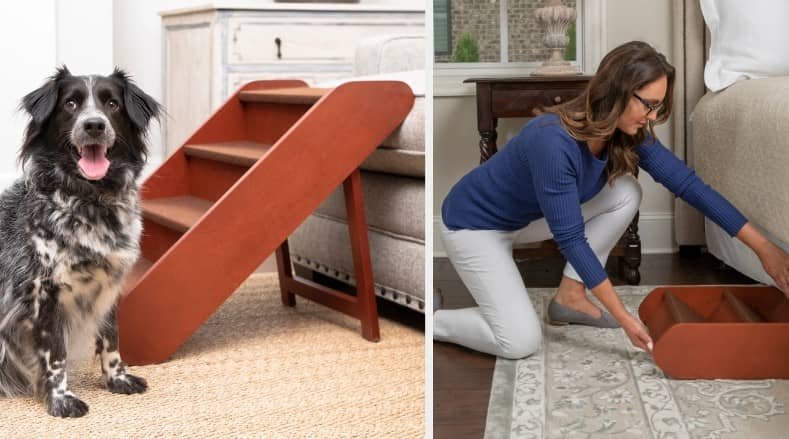Is your dog having a hard time making the leap up to the couch, bed, or car?
As pet parents, we all may face this issue at some point as our furry friend ages or develops joint problems. In that case, dog steps are a great way to help your furry friend get up and down.
But wait a minute! How do I know which step is right for my dog and what kind of features should it have? Don’t worry, we will cover all your questions in this short blog post.
Choosing The Right Dog Steps
Dog steps come in a variety of sizes and weight capacities to accommodate different breeds and sizes of dogs. They are especially beneficial for dogs who are elderly, have mobility or joint issues, or are recovering from an injury. By providing easy access to high surfaces, dog steps can improve comfort and quality of life.
Choosing the right dog steps can make a huge difference in their comfort and safety. Here are some things to consider while choosing the right dog steps.
Size And Weight:
Selecting a dog’s steps requires various factors; one such factor is size and weight. Since different dog breeds are not the same size, similarly, dog steps come in different sizes and weights.
Many dogs struggle with narrow steps, so be careful with this and choose the right size that helps the movement. So the steps should be enough for them to climb.
Additionally, check the weight capacity of the steps to ensure they can safely support your dog’s weight and should be lightweight to be easily moveable for you.
Material:
Dog steps are made up of different materials, including foam, plastic, and wood. Durability and stability, as well as how easy they are to clean and maintain, matter a lot.
The traction must be non-slippery. A non-slippery surface is essential; it will save your dog from slipping and falling. A non-slip surface also gives your dog more confidence when climbing the stairs.
Portability:
Having portable dog steps can be more convenient for you, particularly if you need to reposition them quite often, whether to connect them to your bed, sofa, or car. It can be a massive advantage if your dog’s steps are portable.
Do I Really Need Dog Stairs For My Dog?
Yes, you may need dog stairs if:
- Your dog has recently had an injury or surgery
- You have older dogs that have joint issues or arthritis
- You have a smaller dog that faces trouble jumping onto higher surfaces
- You have a large dog that is difficult to lift and carry
- You have a multi-level home, stairs can help your dog access different areas
- You are traveling, the stairs will help your dog easily in and out of the vehicle
Benefits Of Using Dog Steps For Bed
Using dog steps for bed can prove to be extremely helpful for your furry friend.
- Jumping up and down from the bed can be strenuous for your pet’s joints. Dog steps can reduce stress leading to improved joint health.
- Dog steps allow your pet to successfully get on and off the bed without risking injury.
- Easy access to the bed with dog steps can help your pet sleep better.
Benefits Of Using Dog Steps For Car
Using dog steps in your car can prove to be extremely helpful for your furry friend.
- When dogs climb in and out of cars, they risk injuring their joints or falling. Dog steps allow your pet to get in and out of the car safely, reducing the risk of injury.
- Similarly, It can reduce the impact on joints leading to better joint health.
- Older dogs found it difficult to go in or out of the car so if you are a parent of an older dog then having a dog step is a must-have for you.
- There are chances that when your dog jumps into the car it may scratch or damage the interior part of your car. Having a dog step can give you full control and prevent the chances of damage.
Conclusion:
As pet owners, we always want our furry friends to be happy, safe, and healthy. Making sure they can move around conveniently, whether it’s getting into bed or into a car, particularly for mature dogs or those suffering from joint pain, as they may be more vulnerable to injury. Dog steps can be an excellent way to provide them with the necessary assistance. However, it is important to choose stairs that are of high quality and appropriate for your pet’s needs.
Frequently Asked Questions:
Q1. How can you help your dog not be afraid of stairs?
Start small and use positive reinforcement to help your dog conquer his fear of stairs. Take it slowly, provide support, consider a ramp, and seek professional help if necessary.
Q2. How can I train my dog to go up the stairs?
Start small, use positive reinforcement, start practicing frequently, offer additional support, consider a ramp, and be patient when training your dog to go upstairs.
Q3. Why are dogs afraid of walking the stairs?
One of the leading factors behind your dog’s fear of walking the stairs is a lack of exposure. If a dog has never walked up or down stairs before, he or she may be reluctant or scared to do so. In such cases, the dog must be introduced to stairs gradually.
Q4. What should be considered when choosing dog steps?
Consider your dog’s size and weight, the height of the home furnishings, the material and texture, assembly and storage, design and aesthetics, and cost, while valuing safety and comfort.


